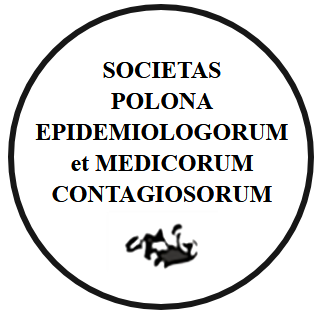Etiological factors of bloodstream infections in oncological Patients, who was hospitalized at the National Institute of Maria Skłodowska-Curie – National Research Institute in Warsaw in 2020-2022
Publication date: 2024-02-02
Przegl Epidemiol 2023;77(3):279-290
KEYWORDS
ABSTRACT
AIM OF THE STUDY.
The purpose of the study was the microbiological analysis of bloodstream infections in patients hospitalized at the National Institute of Oncology, Maria Skłodowska-Curie – National Research Institute in the period from 01/01/2020 to 31/10/2022.
MATERIAL AND METHODS. In the period from 01/01/2020 to 31/10/2022, 18,420 blood cultures obtained from patients hospitalized at the NIO-PIB were analysed in the Department of Clinical Microbiology (total for the presence of bacteria and fungi). Culture for the presence of bacteria was carried out in the BactAlert automatic system by bioMerieux, and for fungi in the Bactec FX automatic system by Becton Dickinson.
RESULTS. 1,184 strains of bacteria and 32 strains of fungi considered to be the etiological factor of the infection were cultured from clinical samples. Gram-positive bacteria accounted for 61.57%, while Gram-negative bacteria accounted for 32.26% of all isolated bacterial strains. The most frequently cultured strains were Escherichia coli – 13.77% (including 22.1% of ESBL strains), Klebsiella penumoniae – 4.6% (44.4% of ESBL strains, 1.85% of NDM strains), Enterobacter cloacae – 2 .7% (including 40.6% of multi-resistant strains: ESBL (15.6%) or with AmpC derepression (25%), among the non-fermenting bacilli, Pseudomonas aeruginosa was the most frequently cultured - 4.18% (including 3.8% MBL) and Acinetobacter baumannii – 0.8% (including CRAB strains 50%, MBL 10%). Anaerobic microorganisms were responsible for 3.46% of blood infection cases. Yeastlike fungi were a factor in 2.7% of all fungemia cases. From blood samples taken Staphylococci were more frequently isolated directly from a vein or through a central venous catheter than aerobic Gram-negative bacilli (44.7% and 25.3% and 55.6% and 12.5%, respectively). The opposite situation occurred in the case of samples taken simultaneously directly from vein and through a central venous catheter, in which a higher share of aerobic Gram-negative bacilli (46.6%) than staphylococci (32.8%) in causing blood infections was observed.
CONCLUSIONS. Gram-positive bacteria are the major contributors to bloodstream infections in cancer patients. There is a growing tendency to develop BSI caused by multi-resistant strains.
MATERIAL AND METHODS. In the period from 01/01/2020 to 31/10/2022, 18,420 blood cultures obtained from patients hospitalized at the NIO-PIB were analysed in the Department of Clinical Microbiology (total for the presence of bacteria and fungi). Culture for the presence of bacteria was carried out in the BactAlert automatic system by bioMerieux, and for fungi in the Bactec FX automatic system by Becton Dickinson.
RESULTS. 1,184 strains of bacteria and 32 strains of fungi considered to be the etiological factor of the infection were cultured from clinical samples. Gram-positive bacteria accounted for 61.57%, while Gram-negative bacteria accounted for 32.26% of all isolated bacterial strains. The most frequently cultured strains were Escherichia coli – 13.77% (including 22.1% of ESBL strains), Klebsiella penumoniae – 4.6% (44.4% of ESBL strains, 1.85% of NDM strains), Enterobacter cloacae – 2 .7% (including 40.6% of multi-resistant strains: ESBL (15.6%) or with AmpC derepression (25%), among the non-fermenting bacilli, Pseudomonas aeruginosa was the most frequently cultured - 4.18% (including 3.8% MBL) and Acinetobacter baumannii – 0.8% (including CRAB strains 50%, MBL 10%). Anaerobic microorganisms were responsible for 3.46% of blood infection cases. Yeastlike fungi were a factor in 2.7% of all fungemia cases. From blood samples taken Staphylococci were more frequently isolated directly from a vein or through a central venous catheter than aerobic Gram-negative bacilli (44.7% and 25.3% and 55.6% and 12.5%, respectively). The opposite situation occurred in the case of samples taken simultaneously directly from vein and through a central venous catheter, in which a higher share of aerobic Gram-negative bacilli (46.6%) than staphylococci (32.8%) in causing blood infections was observed.
CONCLUSIONS. Gram-positive bacteria are the major contributors to bloodstream infections in cancer patients. There is a growing tendency to develop BSI caused by multi-resistant strains.
We process personal data collected when visiting the website. The function of obtaining information about users and their behavior is carried out by voluntarily entered information in forms and saving cookies in end devices. Data, including cookies, are used to provide services, improve the user experience and to analyze the traffic in accordance with the Privacy policy. Data are also collected and processed by Google Analytics tool (more).
You can change cookies settings in your browser. Restricted use of cookies in the browser configuration may affect some functionalities of the website.
You can change cookies settings in your browser. Restricted use of cookies in the browser configuration may affect some functionalities of the website.





